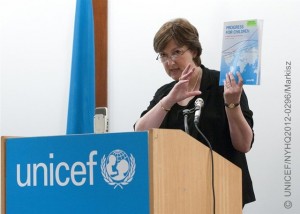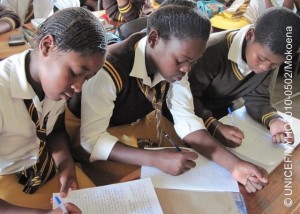Millions of adolescents falling behind, especially in Africa – UNICEF report
2012-04-24

The report, for example, identifies sub-Saharan Africa as the most challenging place for an adolescent to live. The adolescent population of the region is still growing, and it is projected to have the greatest number of adolescents in the world by 2050. But only half the children in sub-Saharan Africa complete primary school and youth employment is low.
Progress for Children: A report card on adolescents highlights other alarming consequences of the benefits of progress not being equally shared among the total of 1.2 billion adolescents – defined by the United Nations as between the ages of 10 and 19 – now living in all the regions of the world.
“The disadvantages of poverty, social status, gender or disability prevent millions of adolescents from realising their rights to quality education, health care, protection and participation,” said UNICEF Deputy Executive Director Geeta Rao Gupta. “This comprehensive report card strengthens our understanding of the problems facing the poorest and most disadvantaged adolescents. It is time to attend to their needs; they must not be left behind.”
![(Left-right) Azara Mohammed, 14, and Humu Baba, 13, visit a guinea-worm containment centre in the town of Savelugu, capital of Savelugu-Nanton District in Northern Region. Both children were previously infected with guinea-worm disease, a painful and debilitating infection caused by a parasite ingested through drinking contaminated water. Children under 16, who are more likely to play in or drink from infected water sources, are most affected. [#1 IN SEQUENCE OF TWO] In September 2008 in Ghana, economic growth and government reforms continue to improve the lives of children and families. The country is on track to achieve several United Nations Millennium Development Goals (MDGs). However, progress is uneven. The northern regions, which account for half of the countrys population living below the poverty line, are the most impoverished, and there are wide regional and rural/urban disparities in child and maternal mortality. And while 78 per cent of the entire population has access to improved drinking water sources and 60.7 per cent have access to improved sanitation, the north lags well behind these percentages. Working with the Government and other partners, UNICEF supports health, nutrition, education and protection interventions, as well as a range of integrated water, sanitation and hygiene (WASH) interventions, including to eradicate guinea-worm disease in endemic districts.](/wp-content/uploads/2015/12/0424_PRC12_boys-300x214.jpg)    |
Childbirth complications lead underdevelopement of adolescent girls
The report points to a significant need for improved investment in all aspects of adolescents’ lives and wellbeing – even in their struggle for survival. Each year 1.4 million adolescents die from road traffic injuries, childbirth complications, suicide, AIDS, violence and other causes. In some Latin American countries, more adolescent boys die as a result of homicide than from road traffic injuries or suicide. In Africa, complications in pregnancy and childbirth are the top cause of death for girls aged 15 to 19. Children entering adolescence are increasingly at risk of violence – a shift from early childhood when disease and nutrition are the major threats. Adolescent girls are particularly vulnerable to violence in marriage. In a survey in the Democratic Republic of Congo, 70 per cent of girls aged 15 to 19 who had been married said they experienced violence at the hands of a current or former partner or spouse. Adolescents, particularly girls, are often forced to abandon childhood and take on adult roles before they are ready, limiting their opportunities to learn and grow, and placing their health and safety at risk. The report says that over a third of women aged 20 to 24 in developing countries excluding China were married or in a union by the age of 18 with about one third of these being married by age 15. Adolescent birth rates are relatively high in Latin America, the Caribbean and sub-Saharan Africa, the report says. In Niger, half of young women aged 20 to 24 gave birth before the age of 18. Secondary school enrolment remains low in the developing world Globally, 90 percent of children of primary school age are enrolled in primary schools and secondary education systems have expanded in many countries. Secondary school enrolment however remains low in the developing world, especially in Africa and Asia. Many pupils of secondary school age are in primary schools. Sub-Saharan Africa has the worst secondary education indicators of any region. Some 71 million children of lower secondary school age worldwide are not in school and 127 million youth between 15 and 24 are illiterate – the vast majority in South Asia and sub-Saharan Africa. |
But the report also notes that adolescents should be recognised as real agents of change in their communities. Programmes and policies, while protecting adolescents as children, must acknowledge their capacity for creativity, innovation and energy to solve their problems.


Click here to read the full report Click here to learn about the Facts on Adolescents









